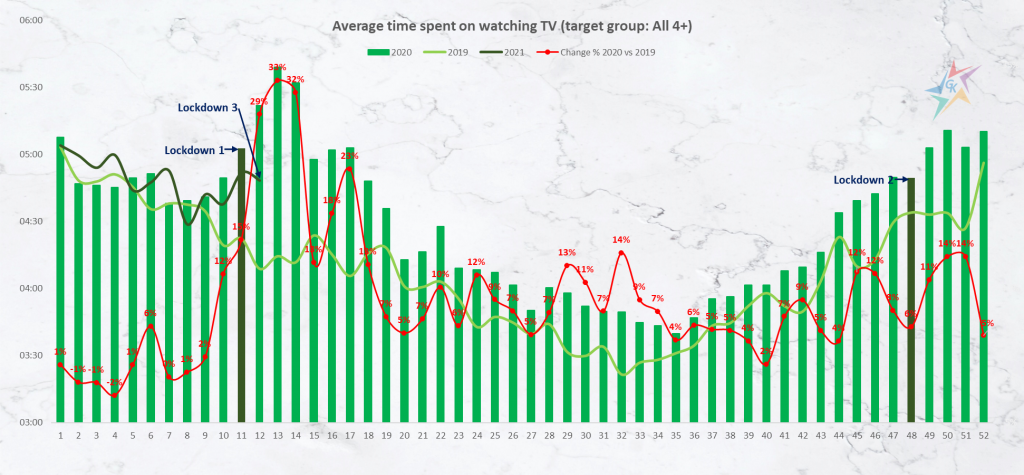Over the past year, our society has been confronted with the Covid-19 virus. With the announcement of the first cases of the contagious disease in the country, a variety changes in people’s daily lives began. Wearing protective equipment, constant disinfection and social distance have taken root in our lives. The time spent in the office or with friends outside was replaced by home isolation. And if in the beginning the attitude was that strict measures for a certain period will stop the spread of the disease, then over time we realized that we must continue our lives with the presence of the virus among us. This is reflected in all aspects of our daily routine. One of the first changes we noticed was in consumer habits and media consumption. The hours spent at home have increased, and this has contributed to the increase in the time we spend in front of the screens of mobile devices, computers and TVs. To get a quantitative idea, we compared the average daily TV viewing time by weeks for 2019, 2020 and 2021 as of March 28:

The data in the chart are for the target group All 4+ (the entire population of the country at 4+ years old). In the first weeks of 2020, the average duration of watching television is close to the values from the previous year.
In the beginning of March, information about the spread of Covid-19 took over the world news and from the 10th week the interest towards television content began to grow.
The 11th week is marked by the official announcement of the first “lockdown” in Bulgaria and by the constant emergency broadcasts with information about what is happening in the country. News blocks become an integral part of television content for everyone. The desire for information continues to grow strongly for a few more weeks, until the moment when the viewer’s attention is saturated and a more moderate growth rate follows compared to 2019.
Although the situation with the spread of the virus seemed to be under control during the summer months, many people are cautious and continue to spend more time at home. This is clear from the chart in which we see constant growth, compared to the summer months of 2019.
The launch of autumn TV formats brings the audience back to the TV screens. The traditional growth in viewership is also influenced by the deteriorating situation related to Covid-19 in the country, which leaves students and a large part of the workers at home again.
The ensuing second lockdown also led to an expected increase in time spent in front of TVs, but this time in a more moderate range. The first weeks of December coincide with the strictest measures imposed in the country, as well as with the final episodes of the popular TV formats. It is clear from the chart that the combination retains the viewer’s attention and the growth achieved on a weekly basis is among the highest since the announcement of the first “lockdown”.
It is important to note that in 2020 the average daily duration of watching TV by the target group All 4+ increases by 9% compared to 2019 and reaches a little over 271 minutes on average per day (more than 4 and a half hours).
The described trend is in line with the world tendency, according to which the time spent by viewers in front of TV screens is slowly and gradually increasing, but the appearance of Covid-19 and the isolation imposed by the virus also have a strong influence on the increase on an annual basis. The growth trend continues in the beginning of 2021 as well. Although the weeks surrounding the announcement of the third lockdown on March 22, 2021, did not mark last year’s picks, the audience continue to spend more time on watching TV – 16% more, compared to the same period, a year before Covid-19.
For additional information, please contact our team via the contact form.

